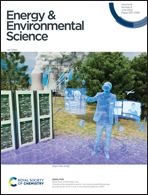Improving the efficiency and stability of perovskite solar cells using π-conjugated aromatic additives with differing hydrophobicities†
Abstract
Perovskite solar cells (PSCs) continue to excite the research community due to their excellent power conversion efficiency (PCE) and relative ease of preparation. Additive engineering has played a decisive role in improving PSC performance and stability. In particular, π-conjugated aromatic additives (CAAs) offer key advantages such as high charge transport. However, the roles of hydrophobicity and structure in determining CAA performance as additives are still being established. Here, we investigate the effects of two coumarin additives on the PCE and stability of PSCs based on Cs0.05(FA0.85MA0.15)0.95Pb(I0.85Br0.15)3 perovskite. The CAAs are coumarin methacrylate (CMA) and coumarin hydroxyethyl (CHE) and were added to the precursor perovskite solutions prior to film deposition with CMA being more hydrophobic than CHE. These additives increase the best PCE of 19.15% for the control to 21.14% and 21.28% for the best devices containing CHE and CMA, respectively. The stability of the devices with the additives are far superior to that of the control (CAA-free) system. The time lengths required for the PCE to decrease to 80% of the initial value for CMA- and CHE-containing devices are 98 and 38 days, respectively, compared to only 14 days for the control. The moisture and thermal stabilities of the systems containing CMA are markedly improved compared to those containing CHE and the control. Our results show that the extents of binding to Pb2+ and passivation increase as the coumarin's hydrophobicity increases which decreases recombination. Our findings show that adding CAAs with increasing hydrophobic character to the precursor perovskite solution is useful for achieving high-performance and long-term stable PSCs.

- This article is part of the themed collections: Recent Open Access Articles and Celebrating the scientific accomplishments of RSC Fellows


 Please wait while we load your content...
Please wait while we load your content...